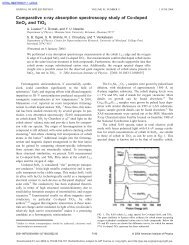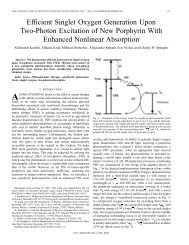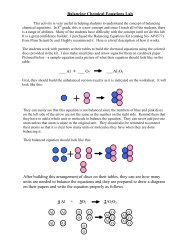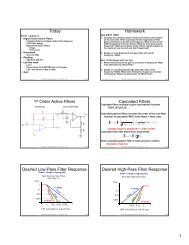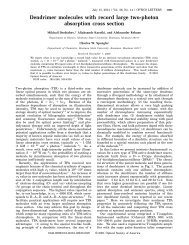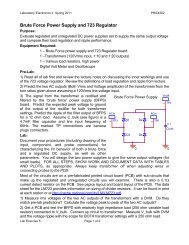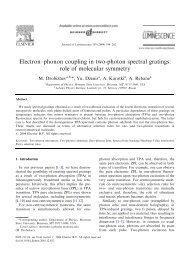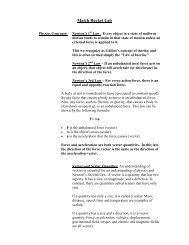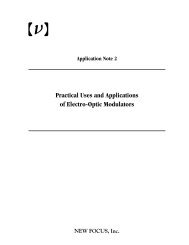Defects in inorganic photorefractive materials and their investigations
Defects in inorganic photorefractive materials and their investigations
Defects in inorganic photorefractive materials and their investigations
You also want an ePaper? Increase the reach of your titles
YUMPU automatically turns print PDFs into web optimized ePapers that Google loves.
<strong>Defects</strong> <strong>in</strong> <strong>in</strong>organic <strong>photorefractive</strong> <strong>materials</strong> <strong>and</strong> <strong>their</strong> <strong>in</strong>vestigations 15<br />
4.2 Extr<strong>in</strong>sic defects<br />
At first the dop<strong>in</strong>gs are treated which prevent or reduce the formation of Nb Li<br />
dur<strong>in</strong>g crystal growth from Li-deficient melts, such as Mg or Zn with concentrations<br />
<strong>in</strong> the percent range. Further <strong>in</strong>formation on such ’optical damage<br />
resistant’ dop<strong>in</strong>gs is given <strong>in</strong> Chapter 6. As has been mentioned above, the reduction<br />
of crystals of this type leads to the formation of almost free electrons,<br />
transformed to Nb 4+<br />
Nb<br />
polarons by coupl<strong>in</strong>g to the lattice. This is an <strong>in</strong>dication<br />
for the absence of Nb Li as trapp<strong>in</strong>g centers. Several additional dop<strong>in</strong>gs <strong>in</strong> such<br />
crystals were <strong>in</strong>vestigated by EPR. The correspond<strong>in</strong>g signals are characterized<br />
by <strong>their</strong> large width, result<strong>in</strong>g from the addition of the dop<strong>in</strong>g-<strong>in</strong>duced<br />
disorder to the <strong>in</strong>tr<strong>in</strong>sic one. Table 1 conta<strong>in</strong>s also <strong>in</strong>formation on the extr<strong>in</strong>sic<br />
defects <strong>in</strong>vestigated <strong>in</strong> such crystals. It was found that additional extr<strong>in</strong>sic<br />
ions tend to be <strong>in</strong>corporated at the Nb-sites of the lattice; apparently it is<br />
more favorable that the Mg ions, rather abundant <strong>in</strong> the melt, replace Li ions.<br />
Fig. 7. Comparison of EPR signals of LN:Cr <strong>and</strong> LN:Fe <strong>in</strong> congruent <strong>and</strong> stoichiometric<br />
LN. Top: ’New’ Cr 3+<br />
Nb<br />
signals (a), characterized by a weak axial crystal<br />
field typical for Nb replacement, as compared to those (b) of ’old’ Cr 3+<br />
Li<br />
with typical<br />
strong axial crystal field [88]. Bottom: In congruent LN the ’old’ Fe 3+<br />
Li<br />
(d) is observed.<br />
In stoichiometric material two additional types of Fe 3+ spectra arise (c) <strong>and</strong><br />
all l<strong>in</strong>es become more narrow [64].<br />
Here it has to be noted that it is rather difficult to determ<strong>in</strong>e from basic arguments<br />
at which site, Li or Nb, cation dop<strong>in</strong>gs will enter LN. Both sites have





